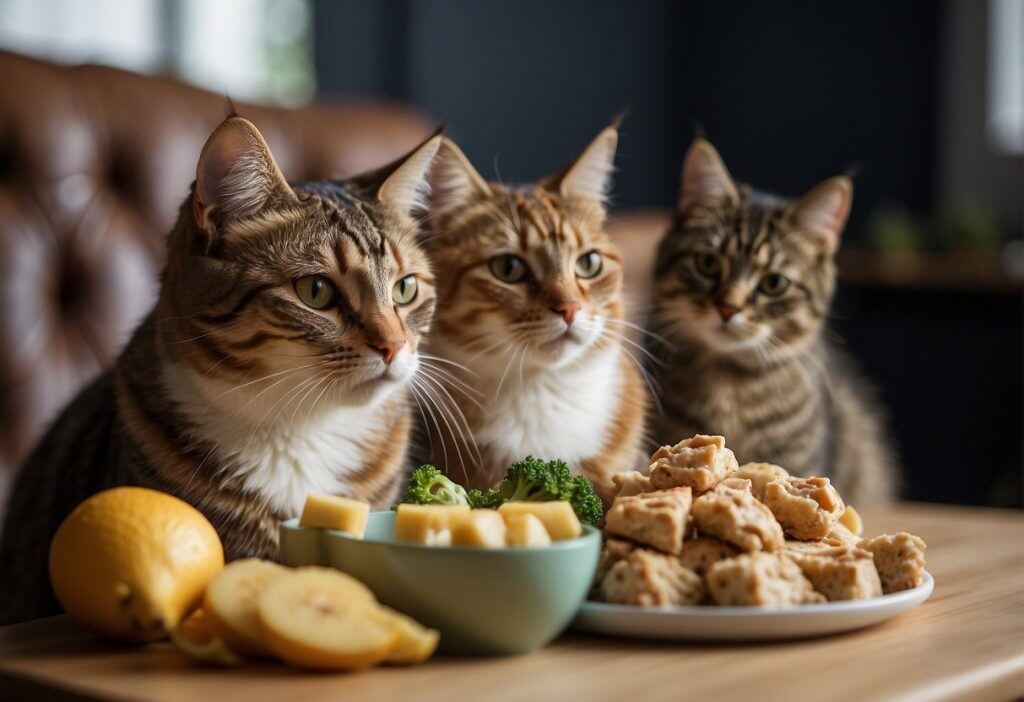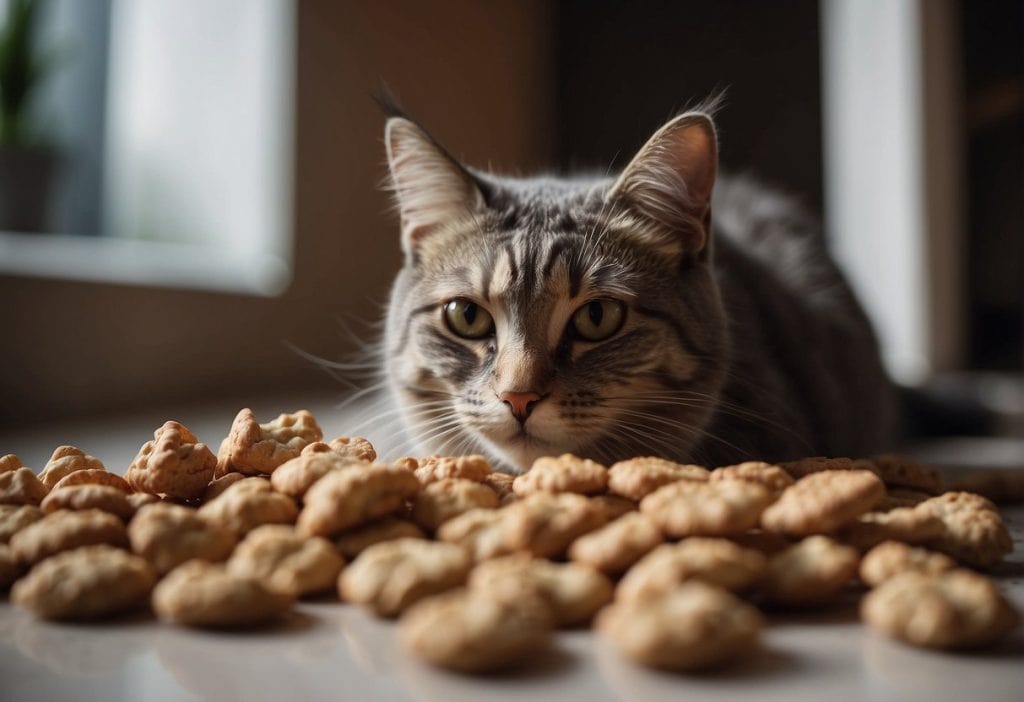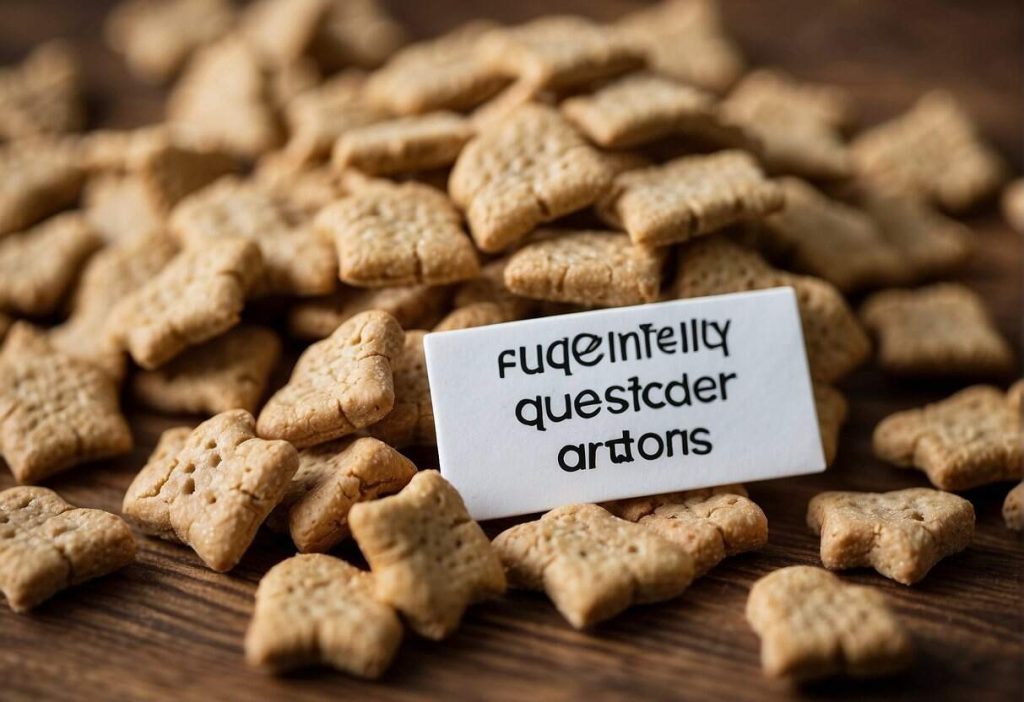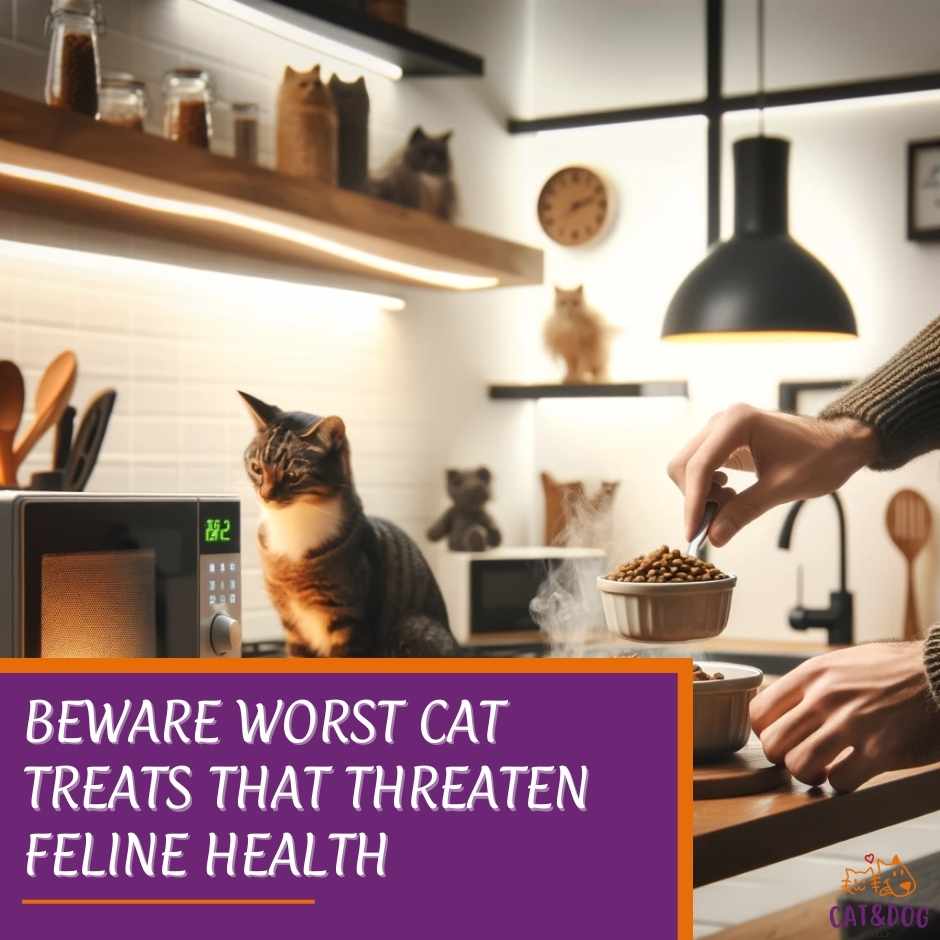When you’re rewarding your fluffy friend with a treat, you’re likely doing it out of love, right?
But did you ever stop to munch on the thought—could these snacks be doing more harm than good? Sure, a nibble here and a bite there seems harmless, but the truth is, not all cat treats are made equal.
Your feline’s nutrition is crucial, and treats, as delightful as they are, play a role in maintaining healthy cat teeth and overall dental health, including preventing bad breath.
Let’s face it; it can be a jungle out there when choosing the best way to pick the right treat for your kitty.
With a market flooded with options, how do you know which treats to avoid? Well, you’ve got questions, and guess what? I’ve got answers.
This article isn’t just about listing the no-no in the world of cat treats.
Key Takeaways
- Not all treats are suitable for your cat’s well-being, so ingredient understanding is key.
- Healthier alternatives are available to replace popular but potentially harmful treats.
- Expert advice can help identify treatment options that benefit your cat’s nutrition, paw-rents can start with nutritious cat food..
Understanding Cat Treat Ingredients
You love spoiling your kitty, right? But did you know some treats might be doing more harm than good? Let’s break it down:
- Artificial Colors: (Yellow 5, Yellow 6, Blue 2, Red 3, Red 40): Sure, they make treats eye-catching, but your cat doesn’t care about the color!
- Preservatives: (BHA, BHT, Ethoxyquin): They keep treats fresh, but at what cost? Research suggests potential health risks.
Risks on the radar include:
- Obesity: Some treats are like junk food for cats. (1)
- Diabetes: Excess sugar and carbs sneak in through treats. (2)
- Dental Issues: Sticky treats cling to teeth, causing decay. (3)
Let’s Chat Labels: How to Read Cat Treat Labels
Ever felt baffled by a cat treat label? Here’s a pro tip: the simpler, the better.
If you can’t pronounce it, your cat probably shouldn’t eat it. Keep an eye out for these red flags:
- Words like “meat by-products” or “animal digest”.
- A laundry list of ingredients.
- High carb content? That’s a no-go.
Embrace treats boasting natural, whole-food ingredients.
Just as you’d choose real chicken over mysterious “chicken flavor”, your cat will thank you for treats with actual meat.
Remember, you’re the gatekeeper to your feline’s health.
Let’s make every nibble count! Keep treats healthy, minimal, and oh-so delightful.
The Worst Cat Treats on the Market
Hey there, fellow cat lover! Have you ever peeked at the ingredient list on your Furball’s treats?
If not, you might be shocked to find some no-good nibbles lurking in their snack drawer.
Don’t worry, I’ve sifted through the noise to clue you in on the potential health hazards of certain cat treats.
Please read the following for a better understanding: Other facilities. Indeed, this is scary stuff.
So, you already know the drill—avoiding certain cat treats is crucial. Let’s make it easy for you:
- Greenies Dental Treats
- Temptations Cat Treats
- Meow Mix Brushing Bites Treats
- Whole Hearted Smart Smiles Dental Treats for Cats
- Whole Hearted Soft Center Crunchy Treats
- Natural Cat Treats True Chews
- Blue Buffalo Wilderness Cat Treats
Many of these worst cat food ingredients can lead to weight gain, allergies, diabetes, cancer, and even death (like aflatoxin mold found in grains).
The very high amount of carbohydrates in these treats will not benefit your cat’s teeth. Cats lack the enzyme amylase in their saliva, which is responsible for breaking down carbohydrates.
So instead of cleaning teeth, carbohydrates leave a starchy residue on the teeth.
Some human foods may also affect your cat’s health, so try to be careful when choosing snacks for your cat.
We suggest buying dehydrated or freeze-dried muscle meat and organ treats, such as chicken meal, chicken liver, and chicken fat, as a healthier alternative for your cat’s daily treat.
Ready to ditch high carbohydrate kibble and switch to a more natural, fresh food diet? My Switch to Raw Blueprint is for you!
Animal fat, a common ingredient in many cat treats, can contribute to weight gain and other health issues in cats.
Poultry fat, another type of fat commonly used in cat treats, can have similar negative effects on your cat’s health.
Low-quality cat foods rely heavily on ingredients like wheat flour and ground corn gluten meal, which are often used as inexpensive fillers to bulk up the product.
There’s no minimum requirement for chicken meal in these treats, which means the amount of chicken meal is guaranteed to be less than 3%. According to a CRS Report for
Brands and No-Nos: Often, it’s the treats with catchy names and fancy packaging that are the culprits. They’re known to sneak in high amounts of sugar and meager protein levels. Here’s a quick rundown:
- Sugar Shock: Look for names ending in ‘-ose’, like glucose or fructose. These sugary fiends have no place in your kitty’s diet.
- Protein Scarcity: Your cat’s snacks should be a carnival of meaty goodness, not a breadcrumb fiesta with grain fillers front and center.
Health Risks on a Plate: It’s not just a case of a few extra pounds; unhealthy treats can lead to a feline version of a human sugar crash and more problematic issues:
- Carrageenan Cautions: This thickener might tickle your kitty’s taste buds, but it’s faced the music for being a potential carcinogen.
- Homemade Hazards: You may think whipping up treats at home is safer, but remember, a balanced diet is key. Tossing together kitchen scraps might miss essential nutrients, leading to health woes.
| Ingredients To Avoid | Why? | Alternative |
| Artificial Sweeteners | Weight gain, diabetes risk | Natural, meat-based |
| Low Protein Content | Muscle loss, energy decrease | High-quality proteins |
| Carrageenan | Potential carcinogen | Natural thickeners |
Moreover, the high-calorie content in many commercial cat treats significantly contributes to the obesity risks in cats, a growing concern that pet owners should be aware of to maintain their feline’s health.
Remember, you’re the guardian of your cat’s health. A little sleuthing goes a long way in keeping them purring and healthy. Choose treats wisely, and your feline friend will thank you with extra cuddles!
Healthier Alternatives to Popular Cat Treats

Curious about treating your cat without guilt? You’re in the right place! Let’s dive into some nutritious and scrumptious alternatives that’ll keep both you and your kitty purring.
Recommended Healthy Treat Options:
Who says treats can’t be healthy? Here’s a list of brands that bring both quality and taste to the table, ensuring your furry friend enjoys every bite without compromise:
- INABA Churu: These wet, lickable treats are not only irresistible to cats but also contain high-quality tuna and salmon.
- Greenies Feline Dental Treats: Crunching on these can help keep your cat’s teeth clean – a win-win for dental care and snacking.
- American Journey: Their grain-free chicken recipe treats are soft, chewy, and free of the grains that some cats are sensitive to.
DIY Cat Treat Recipes:
Fancy making your own treats? It’s easier than you think!
Homemade treats give you control over what your cat consumes and cut down on mysterious ingredients.
- Meat Slivers: Bake thin slivers of chicken, turkey, or liver at 350°F until crispy. Simple and protein-packed!
- Puree Paw-Prints: Puree salmon or chicken and pipe it onto a lined baking sheet. Bake these paw-fect treats and serve them up!
These treats tick the boxes for freshness, simplicity, and health.
You’ll know exactly what’s in them, and guess what? They can be a fun little chef’s project for you, too!
By choosing high-quality commercial treats or whipping up your own, you’re prioritizing your cat’s nutritional needs.
Remember, moderation is key — even the healthiest treats should be a small portion of their diet.
Ready to start your healthy treat adventure? Your cat will surely thank you!
Expert Opinions and Veterinary Advice
Ever wondered what the pros think about those irresistible kitty snacks? Veterinarians are pretty unanimous: the best treats are the ones that match up with your cat’s dietary needs. But what exactly are those needs?
Here’s the scoop:
- Protein Power: Cats are carnivores, so treats high in protein are a major thumbs up. (4)
- Grain Games: While some grain-free treats can be beneficial, they’re not an absolute must. Balance is key.
- Calorie Count: Treats shouldn’t mess up your furry friend’s waistline! Vets often recommend staying within 10% of their daily caloric intake.
Real Talk from the vets:
- “Treats should be just that – occasional,” says one vet. Ain’t no treat special if it’s all the time, right?
- “Ingredients you can’t pronounce are a no-go,” laughs another. If it sounds like a science experiment, maybe skip it.
Nutrition Nuggets:
- Studies have shown that some treats can lead to health issues like obesity or dental problems if given unchecked.
- Positive changes have been documented when switching to more natural and diet-appropriate treats.
Now, let’s lay it out straight. Your cat’s treats shouldn’t be a meal replacement. Think of them like the cherry on top — not necessary, but a nice little extra.
Just remember, you’re in control of those treats times.
Keep it fun and healthy, and you’ll have one great way to incentivize a cat and reinforce that treats are “sometimes food.” This will make the treats even more special for your feline companion.
So, you’ve got this! Next time you’re in the treat aisle, just think like a vet.
Would Dr. Whiskers approve? If you’re ever in doubt, there’s no harm in asking your vet for a bit of guidance. They’re pretty awesome like that.
Addressing Weak Points in Existing Content
Have you ever wondered if those popular cat treats are safe for your furry friend? Let’s take a closer look at some concerning ingredients and what they could mean for your cat’s health.
Health Risks and Ingredient Breakdown:
- By-products and Fillers: Low-quality treats might contain by-products like “salmon by-product” or “animal plasma” which are often undefined and could be less nutritious. (5)
- Artificial Additives: Added sugars and salt in cat treats can lead to obesity or dental issues.
- Preservatives: Chemicals like BHA and BHT are potentially carcinogenic in long-term, high-dose animal studies. (6)
And here are some real-life snippets to consider:
- Greenies Dental Treats: Controversial due to their initial formula, which some pet owners claimed led to health issues. They’ve since been reformulated.
- Temptations Cat Treats: While these are popular, reviews suggest they can be addictive and may not be the healthiest option due to high sugar and salt content.
Table 1: Common Ingredients & Potential Risks
| Ingredient | Potential Risks |
| By-products | Less nutritional value |
| Artificial Additives | Obesity, dental problems |
| Preservatives | Possible carcinogens |
Now, remember, not all treats are bad!
What about some real-world cases? In some reports, cats have become ill from certain treatments due to renal failure or gastrointestinal issues.
However, it’s essential to scrutinize these claims critically. Look at scientific studies and vet opinions to truly understand the risks.
Don’t forget to check customer feedback too—reviews often reveal patterns such as frequent out-of-stock issues or side effects like digestive disturbances.
So, what’s the takeaway? Scrutinize ingredients and look beyond the charming commercials and packaging. Your cat’s health deserves that extra bit of attention!
Quick Recap

Ever wondered why picking the right treats for your furry friend is a big deal? It’s simple!
Why these? Well, some treats might hide not-so-great ingredients that could spell trouble for toothy grins and taut tummies.
You’ve got to be a label detective—keep an eye out for high sugar content and artificial additives, which no kitty needs in their snack stash.
| Look for | Avoid |
| High Protein | High Sugar |
| Iron & Taurine | Artificial Additives |
| Vitamin B | Excessive Carbs |
Remember, your cat’s health is in your hands! So, don’t forget to check with your vet before giving any new treats.
Learning never ends, and neither does your cat’s need for a balanced diet. Keep exploring, and if you ever feel overwhelmed, your vet is just a quick call away.
Do they need tons of treats? Nope. But do they deserve the best ones? Absolutely. You might not find the purr-fect snack overnight, but hey, it’s all part of the adventure. Happy treating!
Frequently Asked Questions

Navigating the world of cat treats can be as tricky as getting your feline friend to obey, but don’t worry! I’ve got your back.
Below are some of the most pressing queries cat owners have coupled with straightforward answers that’ll help keep your kitty happy and healthy.
What ingredients should you avoid when picking out treats for your feline friend?
You should avoid treats with artificial flavors, colors, and preservatives. High carbohydrate content, from sources like corn and wheat, is also a no-go.
Instead, opt for treats with high-quality protein as the main ingredient.
Could certain treats be harmful or even toxic to kittens, and what are the signs to watch for?
Indeed, toxic ingredients like onions, garlic, and chocolate can be harmful to kittens.
Look out for signs of distress such as vomiting, diarrhea, lethargy, or difficulty breathing, and contact your vet if you observe any.
What health issues can arise from poor-quality cat treats?
Feeding your cat treats with low-quality ingredients can lead to obesity, dental issues, and digestive troubles, including food allergies and sensitivities.
Can you suggest any healthy homemade cat treat recipes?
Absolutely! Consider simple recipes like baked tuna or salmon bites, freeze-dried liver morsels, or cooked egg treats.
Remember to keep portions small and use fresh, high-quality ingredients.
Are there some treats that cats with sensitive stomachs can enjoy without worry?
Yes, there are treats specifically designed for cats with sensitive stomachs.
These are usually grain-free, contain a limited number of ingredients, and feature easily digestible proteins.
Yes, there are treats specifically designed for cats with sensitive stomachs.
These are usually grain-free, contain a limited number of ingredients, and feature easily digestible proteins.
Are there any scientific studies about the effects of cat treats on health?
While specific studies on cat treats are limited, research on feline nutrition indicates that high-protein, low-carb treats can support a cat’s health, reflecting their natural carnivorous diet.
How often should I give treats to my cat?
Treats should not exceed 10-15% of your cat’s daily caloric intake.
Consult your vet to determine the exact amount suited to your cat’s age, weight, and activity level, and remember, moderation is key!
- Where to find the most trustworthy real money casinos - August 7, 2025
- Online Casinos That Approve PayPal: The Ultimate Overview - August 7, 2025


